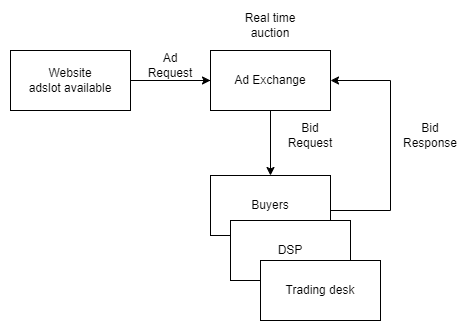Introduction:
In the digital era, the world of online advertising is a bustling marketplace, an industry valued at an astounding $650 billion per year. This blog post delves into the intricate web of this industry, exploring the players, technologies, and trends that are shaping the future of online advertising.

Players in the Online Advertising Industry
- Buyers (Top and Mid-Small Advertisers, DSP): The backbone of the industry, these players range from large corporations to small and medium-sized businesses. The latter often leverage Search Engine Marketing (SEM) for visibility and reach.
- Ad Networks: These are platforms like Google, which provide a vast inventory of ad spaces. They cater primarily to small websites looking to sell ad positions. While these networks deal with long-tail traffic, the quality of this traffic isn’t always guaranteed. They often operate as ‘closed’ networks with exclusive rights to their inventory.
- Ad Exchange: The Open Marketplace. Ad Exchanges create a more open market, connecting buyers (like advertisers, ad networks, trading desks, and DSPs) with sellers (publishers). This setup facilitates the connection of advertisers on a Demand-Side Platform (DSP) with publishers on a Supply-Side Platform (SSP).
- Trading Desks(For Mid-Small advertisers): Trading desks are central hubs for executing programmatic bidding, managing orders, and analyzing metrics. They play a critical role in optimizing advertising strategies and maximizing the effectiveness of ad spend.
RTB
Real-Time Bidding (RTB) is a key process in digital advertising, where ad inventory is bought and sold in fractions of a second. It involves buyers (DSPs) and sellers (Ad Exchanges), with DSPs often integrating third-party verification for transaction settlements.
Data
Data is a crucial element in targeting the right audience. For advertisers, this includes:
- First-class data (advertiser’s user data).
- Second-class data (interaction with the advertiser’s ads).
- Third-party data (including expensive datasets like search engine data, social media data, offline data from airports, POS transactions, and third-party metrics analysis caused by ad interactions).
Industry Standards and Guidelines by IAB
The Interactive Advertising Bureau (IAB) offers guidelines and frameworks for programmatic RTB and OpenDirect specifications.
OpenDirect, for instance, allows publishers to offer premium inventory to a broader range of buyers in a programmatic marketplace.
The OpenRTB standard, integral to platforms like Google’s ad exchange, streamlines the bidding process for multiple impressions.
Emerging Marketing Trends
The trend in online advertising is leaning towards a data-centric approach. Advertisers are placing more importance on data, with companies creating their DSP platforms for ads. There’s also a growing interest in bridging online and offline data. Also the audience targeting technologies.
The Most Important Technologies in Online Advertising
- Cookie mapping and app-to-device ID linking are crucial for identifying and tracking users across platforms.
- OpenRTB technology stands out as a significant advancement, streamlining the bidding process and enhancing the efficiency of ad exchanges.
How RTB works
- User lands on a website
- Website has a adslot open for bidding
- ad request from the website sends to ad exchange
- Ad exchange sends the bid request to buyers(DSP, trading desk, etc)
- within 1s, advertiser need to put a bid and sends a bid response back.
- A realtime auction happens in ad exchange. The winner sends as ad response back to website
- Website renders the ad on the adslot.

Since we are friends, you are welcome to use my text, but please credit the source: https://alwa.info